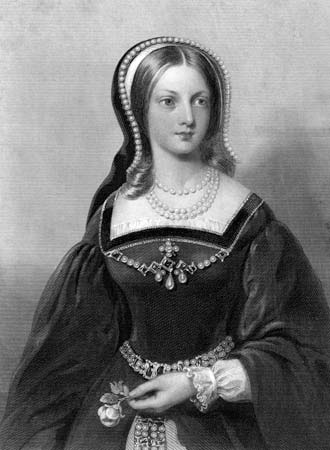Lady Jane Grey is most notably known for being Queen of England for the short period of nine days. Only shortly after ending crowned, she was she was accused with treason and later executed mainly because of her Protestant faith.
The exact date of Lady Jane Grey’s birth is unknown. Perhaps in October of 1537 or earlier that year, or maybe even in 1536. Jane was the eldest daughter of Henry Grey, 1st Duke of Suffolk, and Lady Frances Brandon. Jane’s mother, Lady Frances, was the eldest daughter of Mary, King Henry VIII’s younger sister. Jane and her three sisters were grandnieces to Henry VIII.
Growing up, Jane received an education in Italian, Latin, Greek, and Hebrew. Jane was also very committed to her faith as a Protestant. Her parents were harsh and strict with her, which was not abnormal for the time.
Jane left home to live with Thomas Seymour, the uncle of Edward VII, in early 1547. Thomas Seymour soon married Catherine Parr, Henry VIII’s widow. Catherine died the next year in September during childbirth. After this happened, Jane moved away.
In spring of 1553, Jane was engaged to Lord Guildford Dudley. His father, John Dudley, 1st Duke of Northumberland, was the most powerful man in the country then. Jane and Lord Dudley were married on May 25, 1553.
Henry VIII’s Third Succession Act of 1544 included Jane in line for the throne. But when Edward VI was dying in 1553, he named Jane his successor. On July 6, 1553, Edward VI died. Three days later, Jane found out she was to become queen. Jane was crowned Queen on July 10, 1553. However, Jane refused to allow her husband to be king. Instead, he was offered the position of Duke of Clarence.
Not long after she took the throne, Jane and her husband were charged with high treason. On November 13, their trial took place. Jane, her husband, his brothers, and the former Archbishop of Canterbury were all found guilty. Specifically, Jane was found guilty because she signed documents as “Jane the Queen”. Jane was to be burned alive on tower hill, or be beheaded. The new queen, Mary, would choose whichever punishment she felt fitting for Jane.
In February of 1554, Thomas Wyatt the younger led a protestant rebellion. Jane had had nothing to do with the rebellion, but it was used as another reason for her execution. Originally Jane and her husband’s execution was to be held on February 9, 1554. It was postponed three days because it was agreed upon that Jane should experience the Catholic faith.
On the day of the execution, February 12, 1554, Lord Guildford Dudley was taken from the tower and beheaded. They brought his remains back to the tower to show Jane. She was then taken to be beheaded like her husband. Jane was known to have recited a speech and the last words spoken by Jesus. Later, her and her husband were buried at the Chapel of St. Peter and Vincula.


